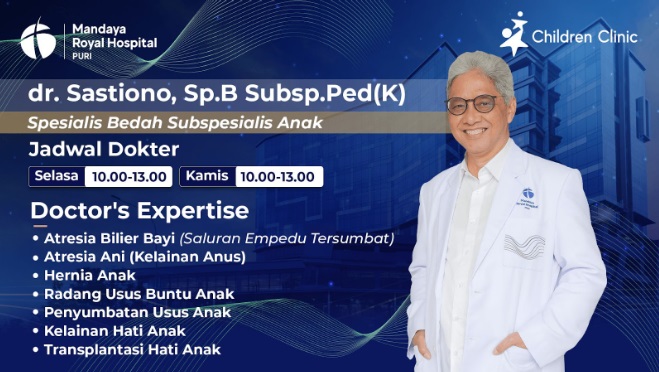Hernia in infants or children can be a major concern for parents, especially when a lump appears in the groin or scrotum area. This condition can occur in both boys and girls, but many parents wonder whether hernias are indeed more common in one gender than the other.
To understand this, it’s important to know how anatomical differences between boys and girls play a role in the development of hernias. By understanding the causes and risk factors, parents can be more alert and seek the right medical treatment promptly if their child shows symptoms of a hernia.
RS Mandaya Royal Puri has an experienced and reputable pediatric surgeon, dr. Sastiono, Sp.B Subsp.Ped(K), who is an expert in diagnosing and treating hernias in children.
Contents
Is Hernia in Children More Common in Boys Than in Girls?
Anatomically, inguinal hernias are far more common in boys than in girls, with a ratio of about 10 to 1. This happens because, during fetal development, a baby boy’s testicles initially form above the lower abdominal wall, then descend through the inguinal canal into the scrotum. The passage through which the testicles descend forms a natural opening in the abdominal wall that can reopen and cause a hernia. In some cases, this opening does not close completely before birth.
In girls, the inguinal canal is narrower and located lower in the abdomen. Inside this canal is the round ligament, which helps support the uterus and strengthen the abdominal muscles. However, if a child has a connective tissue disorder, the risk of developing a hernia can increase, especially where the connective tissue attaches. Although rare, baby girls can also be born with congenital inguinal hernias.
What Are the Symptoms of Hernia in Children?
Young children, especially infants and toddlers, are often too young to describe what they feel, so it’s important for parents to recognize the early signs of a hernia.
Some symptoms of hernia in babies or young children include:
- A lump or swelling around the groin or belly button
- Pain or discomfort in the lower abdomen or groin area
- Unexplained crying or fussiness
- A visible bulge that gets bigger when the child cries, strains, or coughs
Most hernias are not immediately dangerous, but they can lead to serious complications if left untreated. Therefore, if parents notice these signs, it’s important to consult a pediatrician immediately.
Pediatric Surgeon at RS Mandaya Royal Puri — Expert in Treating Hernias in Children

Hernia treatment for children at RS Mandaya Royal Puri is performed by an experienced pediatric surgeon, dr. Sastiono.
dr. Sastiono has extensive expertise in hepatobiliary surgery, which includes procedures involving the liver, gallbladder, bile ducts, and pancreas. He is also recognized as one of the few surgeons in Indonesia highly skilled in performing liver transplants in children.
In addition to hernia surgery, dr. Sastiono has vast experience handling various complex pediatric surgical cases, such as:
- Biliary atresia (blockage of bile ducts in infants)
- Anal atresia (congenital abnormality of the anus)
- Hirschsprung’s disease
- Appendicitis in children
- Intestinal obstruction
- Various liver disorders in children
With his deep experience and expertise, dr. Sastiono ensures that every procedure is performed safely, precisely, and according to the highest medical standards to support optimal recovery for children.

dr. Sastiono, Sp.B Subsp.Ped(K) is available for consultation at RS Mandaya Royal Puri on:
- Tuesday: 10.00 – 13.00 WIB
- Thursday: 10.00 – 13.00 WIB
For your convenience, appointments can be made through WhatsApp Chat, Book Appointment, or the Care Dokter App, available on Google Play and App Store, to easily manage your visit, check queue numbers, and get complete hospital information.



